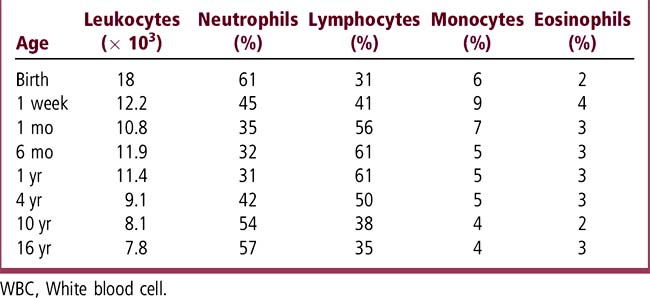Chapter 51 Elevated or Depressed White Blood Cell Count
The white blood cell (WBC) count is often obtained to screen for infection or in response to a wide variety of clinical problems. Interpretation of results depends on knowledge of the changes that occur from birth to adolescence. It also demands an appreciation of how the WBC count varies in different disease states.
ETIOLOGY
How Do White Blood Cells Vary with Age?
At birth, an infant’s WBC count is high and the differential shows a predominance of neutrophils. This neutrophilic predominance is brief, and by 1 month of age the lymphocytes predominate. The WBC count and differential pattern become similar to that of an adult during early adolescence (Table 51-1). Both leukocytosis and leukopenia can indicate infectious, immunologic, or malignant processes (see Chapter 63 for leukemia).
What Causes an Elevated White Blood Cell Count?
Elevated WBC or leukocytosis is most commonly associated with bacterial infection when there is also predominance of neutrophils and immature (band) forms. A WBC count of 15,000/mm3 or higher, with an immature or “band” neutrophil count of 1500/mm3 or higher, is especially concerning when accompanied by clinical signs of “toxicity.” Leukocytosis also accompanies hemorrhage and hemolysis as a result of increased bone marrow activity. Leukocytosis with mature forms occurs after exercise, from the release of marginated neutrophils. Metabolic disorders, leukemia, myeloproliferative disorders, and treatment with steroids, epinephrine, and cytokines also cause leukocytosis. Lymphocytosis with mature lymphocytes is associated with viral illness, notably mononucleosis. If a marked lymphocytosis is seen, pertussis must be considered. Eosinophilia is associated with allergies, eczema, parasitic infections, neoplasm, asthma, and collagen vascular disease.
What Causes a Depressed White Blood Cell Count?
A depressed WBC or leukopenia count usually occurs in response to viral illnesses, drug exposure, or malignancy, and manifests as either lymphopenia or neutropenia. Lymphopenia is associated with an increased risk of opportunistic infections in congenital immune deficiency syndromes and human immunodeficiency virus (HIV) infection. Neutropenia is defined as an absolute neutrophil count (ANC) of less than 2500/mm3 in the newborn and less than 1500/mm3 in children and adults. The chances of bacterial infection increase dramatically as ANC decreases. Fever in a patient with a neutrophil count less than 500/mm3 represents a medical emergency and calls for a complete investigation for bacterial infection and the early institution of broad-spectrum antibiotic therapy.
What Causes Neutropenia?
Neutropenia results from decreased production or increased destruction of neutrophils. Transient neutropenia occurs most commonly during a febrile viral illness from temporary marrow suppression, with decreased production of neutrophils. The neutrophil count typically returns to baseline as the viral illness resolves, but if the count is less than 500/mm3, blood cultures and the institution of broad-spectrum antibiotics should be considered. Malignancy, especially leukemia, causes neutropenia, as do aplastic anemia and a number of rare syndromes. Cyclic neutropenia is manifested by oscillations in the neutrophil count, with the nadir occurring approximately every 21 days, associated with fever and oral ulcerations; within days, the neutrophil count cycles back up, and the child improves. Immune-mediated neutrophil destruction can also occur as an isoimmune phenomenon, as a result of viral infections, in autoimmune disorders, or as an idiopathic phenomenon called chronic benign neutropenia. Hypersplenism destroys WBCs (and red blood cells [RBCs]) in the sinusoids of the spleen. Pseudoneutropenia reflects increased margination of neutrophils in the vasculature; stress usually results in a prompt release of neutrophils into the circulation. Neutropenia can be seen at or shortly after birth in severe congenital neutropenia (Kostmann’s neutropenia), as the first finding in congenital bone marrow failure syndromes (Fanconi’s anemia), and in idiopathic aplastic anemia. A complete medication history is essential in evaluating the causes of neutropenia.
Stay updated, free articles. Join our Telegram channel

Full access? Get Clinical Tree



